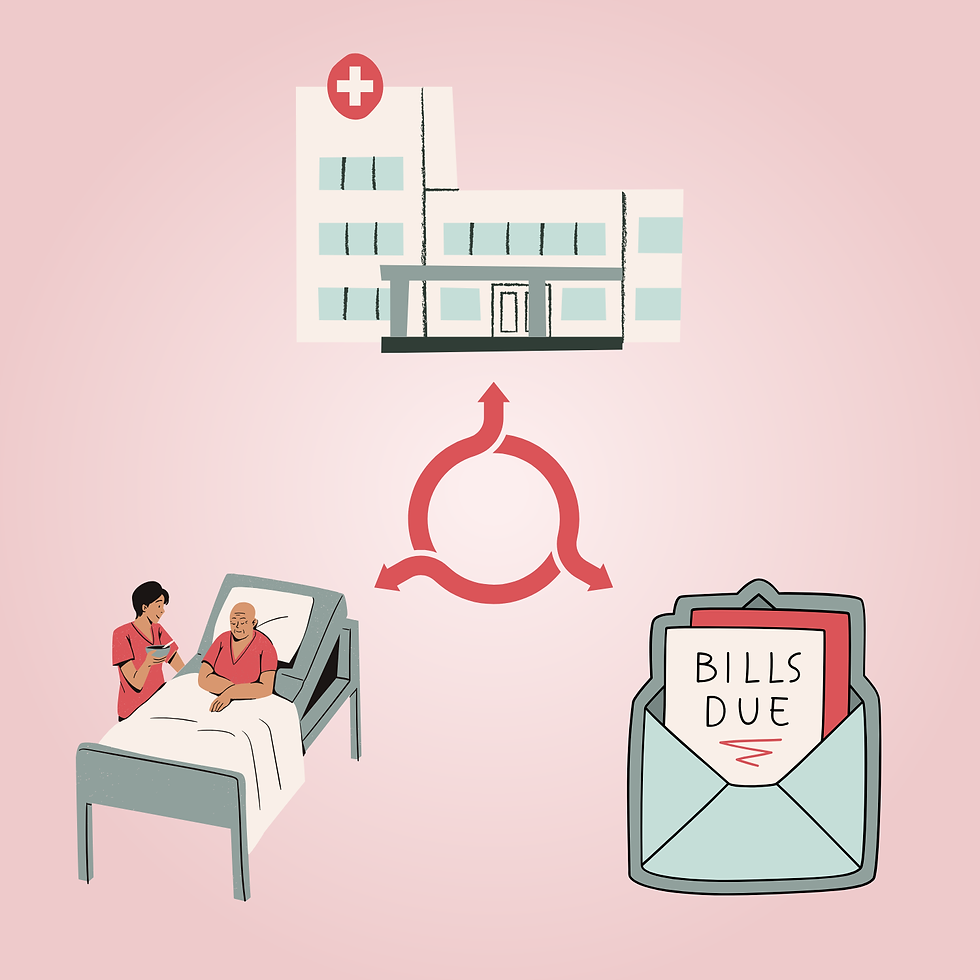Premium Aging: The Growing Cost of Nursing Home Care
- Natalie Gaslin
- Oct 26
- 3 min read
About 0.4% of the entire population of the United States lives in nursing homes, making up one of the most high-risk medical groups in the country [1]. It is a common misconception that nursing homes are the best option for an elderly person with complex medical needs or dementia. While they are able to provide continuous care, the quality of the facilities is often poor, and many are understaffed and underfunded, causing them to crowd more patients into smaller rooms and spend less time with each individual resident. Many nursing homes and assisted living facilities in the United States are common breeding grounds for communicable diseases that put patients’ fragile immune systems at risk. To make matters worse, many high-end skilled nursing facilities won’t accept Medicaid coverage, creating a divide between those who can afford clean accommodations and high quality care and those who cannot. The transition itself can also be a detriment to an elderly person’s health, since it is often an abrupt and jarring change that may cause them to feel a loss of self and autonomy [2].

But nursing homes haven’t always been the only option. For centuries, people have lived in multigenerational households with parents, children, and grandparents all under the same roof, which allows elderly individuals to grow old peacefully in a familiar home, surrounded by family and friends who can provide the care and attention that they need. However, when independent societies like the United States put more emphasis on people owning their own homes away from family in the 1950s and 1960s, they started pushing the elderly out of family homes and into nursing homes [3]. Now, in the 2020s, multigenerational housing is on the rise again, as people feel the pressures of inflation and the cost of living crisis, and are turning to sharing homes with their extended family to save money on mortgages, rent, and nursing home fees.
This idea is also the basis of the Medicaid-funded home and community-based care program that allows elderly people to live at home and retain their community connections while also being supported by a skilled medical team and receiving at-home care as needed. However, current budget cuts to Medicaid have left 700,000 on the waitlist for these home care programs and more people are being forced into nursing homes every day [4]. This problem is exacerbated by the flux of Americans returning to in-person work after the pandemic, with many opting to pay out of pocket for nursing home care for their loved ones, since they cannot take care of them any longer and the home-based care programs have decades-long waitlists.
Additionally, many working-class Americans plan their finances under the assumption that they will be living at home for the majority of their elderly years, but many conditions, such as stroke or dementia, are difficult to predict and can have a very rapid onset. In one study, about 83% of adults reported that they would have great difficulty paying for the estimated cost of one year in a nursing home or one year of at-home assistance, which is between $60,000 and $100,000 [5]. This means that if these individuals needed the assistance of a nursing home, they would likely have to apply for Medicaid, which many higher-end nursing homes will not accept as payment, or rely on family or friends to partially fund their stay. The reality is that many elderly people are forced to enter overcrowded and underfunded nursing homes as a last resort either due to their financial situation or their family’s inability to care for them. The United States needs to amplify their Medicaid-funded home-assistance programs in order to provide the best quality geriatric care possible and allow elderly people to enjoy the final years of their lives with their family instead of being forced to live in a nursing home.
Reviewed by: Ayan Jung
Designed by: Ariha Mehta
References: [1] Bakx, P., Wouterse, B., van Doorslaer, E., & Wong, A. (2020). Better off at home? Effects of nursing home eligibility on costs, hospitalizations and survival. Journal of Health Economics, 73(73), 102354. https://doi.org/10.1016/j.jhealeco.2020.102354.
[2] Grabowski, D. C., Chen, A., & Saliba, D. (2023). Paying for Nursing Home Quality: An Elusive But Important Goal. Journal of the American Geriatrics Society, 71(2), 342–348. https://doi.org/10.1111/jgs.18260.
[3] Ruggles, S. (2007). The Decline of Intergenerational Coresidence in the United States, 1850 to 2000. American Sociological Review, 72(6), 964–989. https://doi.org/10.1177/000312240707200606.
[4] Stedman, N. (2025, July 2). How Medicaid Cuts Could Force Millions Into Nursing Homes. Penn LDI. https://ldi.upenn.edu/our-work/research-updates/how-medicaid-cuts-could-force-millions-into-nursing-homes/.
[5] Hamel, L., & Montero, A. (2023, November 14). The Affordability of Long-Term Care and Support Services: Findings from a KFF Survey | KFF. https://www.kff.org/health-costs/the-affordability-of-long-term-care-and-support-services/.



Comments